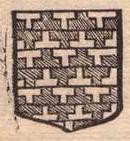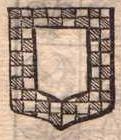The Table of Houses
![[table of houses] [table of houses]](images/xvi-table-of-houses.jpg)
THose are called Accidents, which are not Necessary Parts, but such as being taken away or chang’d, the Substance of the Arms is still the same. They are two, Tinctures and Differences.
Paragraph 1. Tincture is the different Hew of Arms, and things born therein; and is common to the Differences, as well as to the Arms themselves.
Tincture is either of Colour or Furr.
Diatriba 1. We have nothing to do here with the Natural Colour of Things (tho’ that also must be carefully regarded) but our Business is to make mention of such Colours only as are us’d in Heraldry; and they are Nine, viz.
Two Simple, as White and Black.
Seven Mixt, as Red, Yellow, Green, Blew, Purple, Tawny and Sanguine.
Note 1. The Two last seldom serve for the Colours of Fields, being called Stainand Colours, and used to signify some Disgrace, or Blemish of Honour or Vertue, in the Bearer; as you may read in the 3rd Section of this Chapter, in the 2d. Diat. of the 1st. Parag.
Note 2. White and Yellow are called Metals, representing Silver and Gold, the rest Colours.
Note 3. That Coat is assuredly false, wherein there is Metal upon Metal only, or Colour upon Colour only, that is, Gold upon Silver, Silver upon Gold, Blew, Red, &c. upon one another; But this Rule ceases, if page xiii a Coat be Paly, Barry, Quarterly, Checkie, or Party per Pale, Chevron &c.
Note 4. In blazoned the Arms of Gentlemen, &c.
| Yellow | ⎫ | is called | ⎧ | Or. |
| White | ⎪ | ⎪ | Argent. | |
| Red | ⎪ | ⎪ | Gules. | |
| Blew | ⎪ | ⎪ | Azure. | |
| Black | ⎬ | ⎨ | Sable. | |
| Green | ⎪ | ⎪ | Vert. | |
| Purple | ⎪ | ⎪ | Purpure: | |
| Tawney | ⎪ | ⎪ | Tenne, | |
| Sanguine | ⎭ | ⎩ | Sanguine |
|
In the Arms of Noble-men |
⎧ | Topaz. |
|
In the Arms of Kings, &c. |
⎧ | Sol. |
| ⎪ | Pearl. | ⎪ | Luna. | |||
| ⎪ | Ruby. | ⎪ | Mars. | |||
| ⎪ | Saphire. | ⎪ | Jupiter. | |||
| ⎨ | Diamond. | ⎨ | Saturn. | |||
| ⎪ | Emerald. | ⎪ | Venus. | |||
| ⎪ | Amethyst: | ⎪ | Mercury: | |||
| ⎪ | Jacynthe, | ⎪ | Dragon’s-Head. | |||
| ⎩ | Sardonix | ⎩ | Dragon’s-Tail. |
Of Furrs; and they are in Heraldry, White; Ermine, which consists of White distinguish’d with Black Spots; Ermynes, which is Black powder’d with White; Erminois, Black powder’d with Yellos; Pean, the contrary; Ermynites, the same with Ermyne, only it has a Hair of Red on each Side the Black.
There are other Sorts of Doublings (or Furrs) differing from those I have mention’d, in Form and Name.
1. Verrey, which is compounded of Argent and Azure; an Example of which is in Dr. Atterbury’s, Mr. Aston’s of Gloucest. and many other Coats.
But if your Verrey consist of any other Metal and Colour or Furr; see the Arms of Duffield, Estanton and Drake of Greslow. page xiv
2. Potent-Counter-Potent, of which (because I do not remember to have seen it in all my Collections) the Form follows,

Neither do I find that it is fix’d to any Colours, but that the Blazoner is to name those whereof it does at any time consist.
3. Vaire, which (as some will have it) consists of four Colours together, viz. Argent, Gules, Or and Sable; but I chuse (with Gwillem) to make it the same as Verry.
Parag. 2. Differences; are extraordinary Additaments, whereby Bearers of the same Coat-Armour are distinguish’d each from others, and their nearness to the Princial Bearer is demonstrated.
| Differences are |
{ |
Ancient |
Diat. 1. For Differences in ancient Times they us’d Bordures and Imbordurings of several Sorts.
The Plain Border first, which is said to resemble the Fimbria’s the Israelites wore on their Garment: And in blazoning must be called a Border, wihout mentioning its Plainness. The Content of the Border, is the fifth Part of the Field.
Note. When the Field and Border are both of one Tincture, you are not then to say, He beareth a Border, but He beareth such a Metal, Colour or Furr, Imbordured.
Besides this, there are other Borders, which consist of one Tincture only, but being compos’d of the diferent Lines, hereafter mention’d, have quite another Form.page xv
Note. Some Borders consist of more Colours than one (these are mostly compos’d of the strait Line) and are
Counter-componed, as in the Example following,
 :
:
He beareth Azure, a Border Counter-componed, Or and Gules.____Counter-compony consisteth of no more than 2 Tracts.
Checkie, which is like the former, but that it consisteth of many Tracts.
Borders (as the Fields themselves) are subject to be charg’d with things Natural and Artifical; as with Birds, and then your Border is said to be charg’d with Enaluron of such or such Birds, to such a Number; Beasts, and then it is Enurny; Vegitables, and then ’tis call’d Verdoy; Furrs, and then Perflew; a Border charged with things inanimate, of what kind soever, is said to be Entoyre. See the first Appendix.
There are several other Kinds of Borders, of which in the following Sheets you will find Examples.
Diat. 2. The Modern Differences, which not only distinguish Houses, but the diferent and subordinate Degrees in each, are, the File, Crescent, Mullet, Martlet, Annulet and Fleur de Lis. Of which view the following Scheme, which distinguish’d by Figures on the Top and in the Margin, shows the different Houes and Degrees.page xvi
![[table of houses] [table of houses]](images/xvi-table-of-houses.jpg)
It must be remember’d, that Sisters have no Differences, for they are always equal.